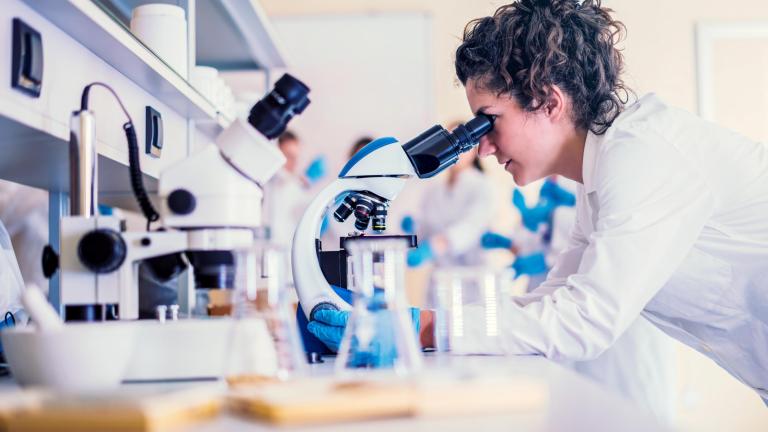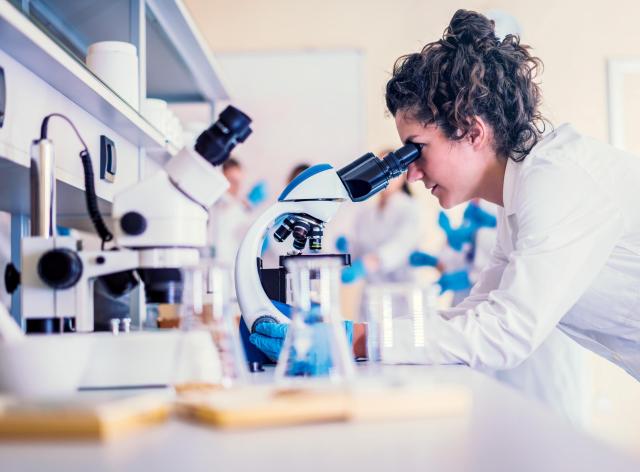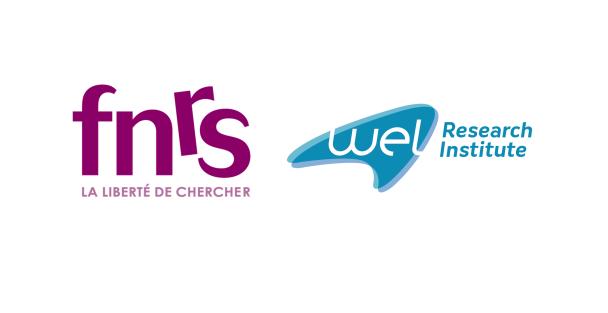The Biology Department strives to understand the living world in all its diversity, in the course of its evolution, from molecules to ecosystems, and to respond to complex societal problems such as biodiversity loss, infectious diseases, antibiotic resistance, etc. Biologists use an approach that integrates the laboratory, the field and computer tools.
Find out more about the department
Biology is a modern science on the move. It responds to complex societal problems such as biodiversity loss, antibiotic resistance, adaptation to climate change, the fight against chronic or infectious diseases, food safety... In short, biology is present everywhere in society.
Biology uses a wide range of scientific and technological knowledge and approaches that enable it to address the living world in all its diversity (viruses, bacteria, fungi, plants, parasites, animals, humans), throughout its evolution and at all levels of organization (molecules, cells, tissues, individuals, super-organisms, populations, ecosystems).
From knowledge of fundamental processes to multiple applications, the 21st century biologist is a complete scientist, wielding the scientific approach, as much in the laboratory as when out in the field (in natural areas) or when using computer analysis methods (and processing high-throughput data).
Spotlight
News
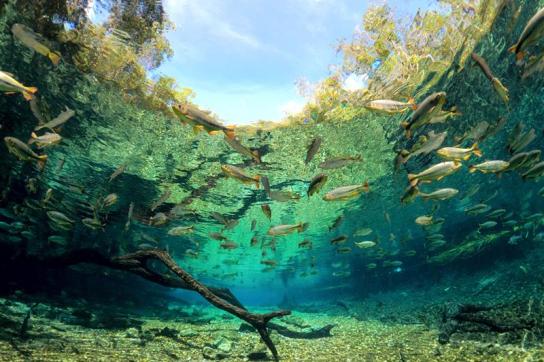
Biodiversity of American rivers analyzed over 30 years
Biodiversity of American rivers analyzed over 30 years
A team of American researchers, with the help of Frédérik De Laender, professor in the Department of Biology at UNamur, has just published in the prestigious journal Nature. Their study describes how changing stream temperatures and human introductions of fish can alter river biodiversity in the USA.
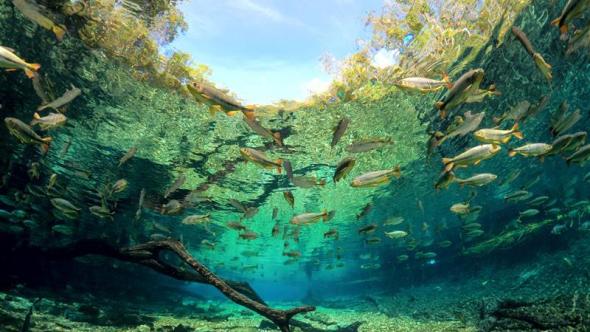
In 2021, Professor Frédérik De Laender was approached by American researchers to contribute to a study on the evolution of aquatic diversity in rivers in the USA. The aim: to analyze changes in aquatic diversity and identify the factors behind them. To answer this question, the researchers analyzed data collected over thirty years, covering 389 fish species in nearly 3,000 rivers and streams.
"There was already a lot of data on aquatic diversity in the USA, but it was scattered, recorded in different formats and produced using a variety of techniques and methodologies," explains Frédérik De Laender. "The challenge was therefore to harmonize them, in order to form a coherent whole, capable of revealing trends over several decades and on a continental scale."
Observed trends
In this study entitled "Diverging fish biodiversity trends in cold and warm rivers and streams" researchers studied 389 fish species in 2,992 rivers and streams, between 1993 and 2019. The results show contrasting trends depending on water temperature:
- In cold waters (< 15.4°C), the number of fish fell by 53% and the number of species by 32%. Small fish have declined, replaced by larger species often introduced for sport fishing.
- In warm waters (> 23.8°C), by contrast, the number of individuals has increased by 70% and diversity by 16%, with small opportunistic species dominating.
- Intermediate streams (15-24°C) showed little change.
These trends show that temperature changes and the introduction of certain fish species for fishing are helping to transform local aquatic communities.

The good news is that our results also indicate that targeted management actions, such as river restoration, limiting introductions or adapting fishing practices, can have a positive impact.
Frédérik De Laender - Mini CV
Frédérik De Laender is Professor in the Biology Department at the University of Namur, where he heads the Environmental Ecology of Ecosystems Laboratory (ECCOLOGY lab). He is director of the Environmental and Evolutionary Biology Research Unit (URBE) and also a member of the Life-Earth-Environment (ILEE) and Complex Systems (naXys) Institutes at UNamur.
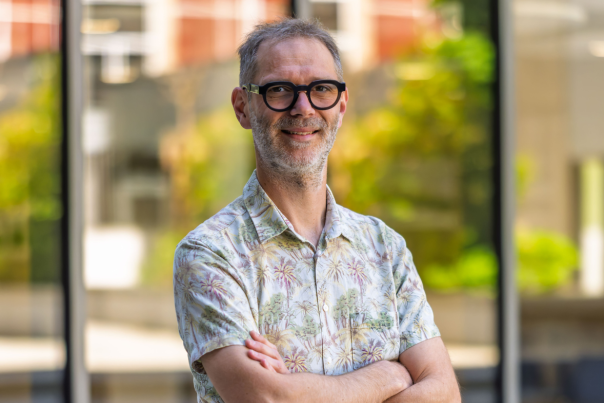
Frédérik De Laender is a theoretical community ecologist who studies the links between environmental change, biodiversity and ecosystem functioning. Primarily focused on modeling, he has also conducted experiments on plankton and contributed to meta-analyses. His work focuses in particular on ecological stability and coexistence, to better understand the mechanisms that determine community composition.
La recherche au Département de biologie
Le Département de biologie, riche de ses professeurs permanents mène une recherche scientifique internationale de pointe. Celle-ci se répartit entre 5 unités de recherche abordant des thématiques variées de biologie cellulaire et moléculaire, de microbiologie moléculaire, de biologie environnementale et évolutive, de biologie végétale et de didactique.
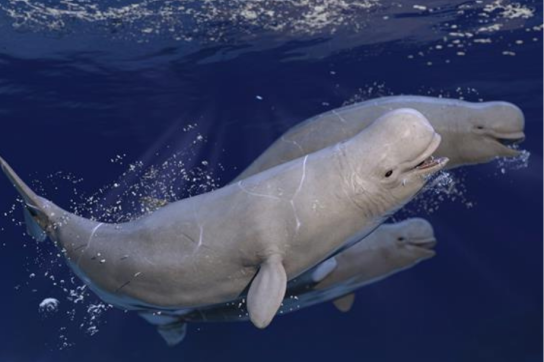
Understanding for better protection: an innovative joint FNRS-FRQ research project on the St. Lawrence beluga whale
Understanding for better protection: an innovative joint FNRS-FRQ research project on the St. Lawrence beluga whale
A project submitted by Professor Frédéric Silvestre's Laboratoire de Physiologie Évolutive et Adaptative (LEAP) at the University of Namur has been ranked among the top 6 research projects funded by the FNRS and the Fonds de recherche du Québec (FRQ) for scientific collaboration between Wallonia and Quebec. The aim? To understand the impact of human activities on St. Lawrence Estuary (SLE) belugas, using interdisciplinary approaches to help improve conservation strategies for this threatened species.
.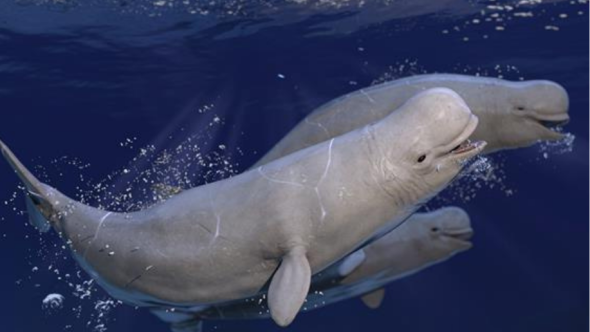
The beluga whale (Delphinapterus leucas) of the St. Lawrence Estuary (SLE) in Quebec, Canada, lives in a marine ecosystem heavily impacted by human activities and has shown no signs of recovery for several decades. Also known as the white whale or white dolphin, the beluga has a life expectancy of around 70 years. Infectious diseases and an increase in post-partum mortality in females have been observed, but the exact causes remain undetermined. However, exposure to contaminants is thought to be one of the causes of the increase in early mortality observed in recent years.
One of the main limitations to assessing the health of individuals in this population in relation to contaminant exposure is the lack of a method for determining the age of live beluga whales in the ESL.
Until now, the most reliable method for determining their age was to count the growth streaks on the inside of their teeth. The expertise of Namur-based researchers at Professor Frédéric Silvestre's Laboratoire de Physiologie Évolutive et Adaptative (LEAP) will enable the development of a new "epigenetic clock" and its use to estimate the age of living belugas, ultimately improving conservation strategies to help this threatened population recover.
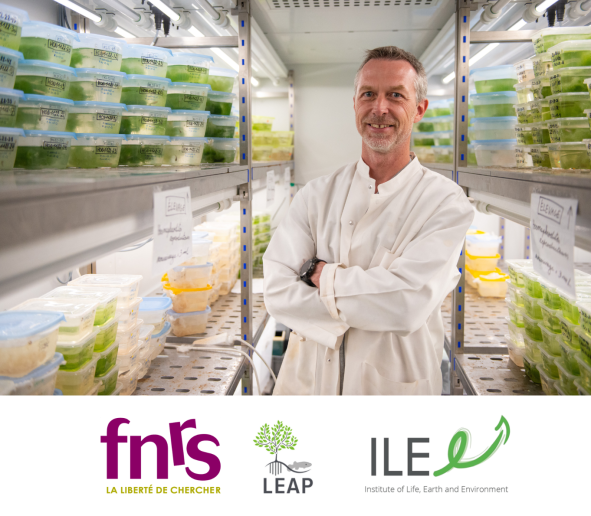
An epigenetic clock to determine the age of belugas
The project is entitled: "Une horloge épigénétique pour estimer l'âge des belugas du Saint-Laurent et son impact sur l'accumulation de contaminants, le stress et la santé de cette population menacée"
Epigenetics is the study of changes in gene activity, not involving modification of the DNA sequence, that can be transmitted during cell divisions. One of the elements that "regulate" gene expression is methylation: a chemical group that attaches itself to certain places on the DNA strand to promote or limit gene expression. In recent decades, it has been discovered that methylation changes in a predictable way during aging, according to a pattern known as the "epigenetic clock". Once this clock has been established for a given population of individuals, it is therefore possible to deduce an individual's age by looking for the presence or absence of methylation on DNA. All it takes is a few cells, such as skin cells.
An international, interdisciplinary team
A team of top scientists from both regions is involved.
- Pr Frédéric Silvestre and Dr Alice Dennis - UNamur, Belgium
- Dr Krishna Das - ULiège, Belgium
- Dr Jonathan Verreault - Université du Québec à Montréal, Canada
- Dr Stéphane Lair - Université de Montréal, Canada
- Dr Magali Houde - Environment and Climate Change Canada
- Dr Véronique Lesage - Fisheries and Oceans Canada
- Dr Robert Michaud - Group for Research and Education on Marine Mammals (GREMM), Quebec, Canada
Namur's expertise to preserve biodiversity
The research team will validate this new method and investigate the link with contaminant accumulation, physiological stress and overall health in this threatened population, comparing the ESL population with a healthier population of belugas from the Canadian Arctic.
In summary, this research aims to better understand how biological age, as measured by the epigenetic clock, influences the vulnerability of belugas to environmental stressors and their health.
This project will address fundamental research questions never before explored in beluga whales,
A new PhD student will join the Namur team, under the supervision of Frédéric Silvestre and will work in collaboration with researcher Justine Bélik on the basis of the EpiClock she developed for the mangrove rivulus.
Along with a project on mangrove rivulus in Florida and Belize, and one on fish and invertebrate populations in the Ecuadorian mountains, this is the third scientific project to use Namur researchers' expertise in ecological epigenetics in wild animals to help preserve biodiversity.
FNRS - The freedom to search
Collaborative research F.R.S.-FNRS - FRQ (Fédération Wallonie-Bruxelles - Québec)
The F.R.S.-FNRS has launched PINT-Bilat-P calls for bilateral research projects with the Fonds de Recherche du Québec. These calls are part of a drive to develop strategic partnerships. The aim of this bilateral research program is to create a leverage effect for scientific excellence and to encourage researchers from the Wallonia-Brussels Federation and Quebec to develop innovative joint research projects.
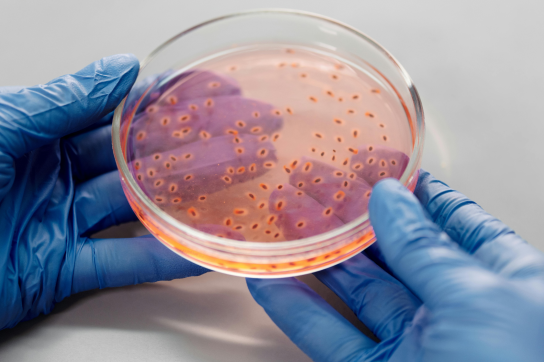
A prestigious publication for an international microbiology research team
A prestigious publication for an international microbiology research team
The team of professor Xavier De Bolle has just published an article in the prestigious EMBO Journal published by Springer Nature. His discovery? A lipid transport channel through the cell membrane of Brucella, the bacteria responsible for Brucellosis in cattle. This finding could be used to generate attenuated strains of the bacteria; a process used in vaccine manufacturing.
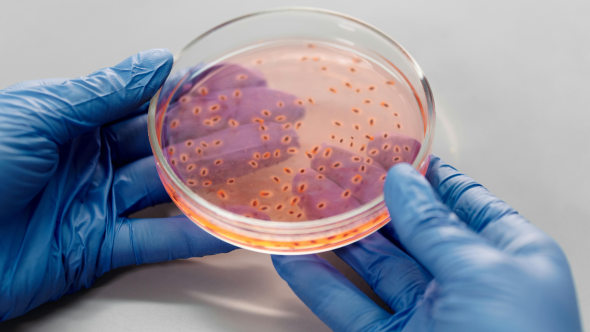
The study of Brucella is one of the areas of microbiology in which UNamur research teams have specialised for more than twenty years. This pathogenic bacteria infects livestock, causing Brucellosis, a disease that can be transmitted to humans through the consumption of unpasteurised dairy products, contact with infected animal tissue or inhalation. It is one of the most widespread zoonoses in the world.
A catalogue of weaknesses
Over the years of research, the team led by Professor Xavier De Bolle, Professor in the Department of Biology, member of the Microorganism Biology Research Unit (URBM) at the University of Namur and investigator at the WEL Research Institute, has been able to establish a kind of “catalogue” of Brucella's weaknesses.
There are millions of species of bacteria. It is therefore impossible to study them on a case-by-case basis. However, they have similar behaviours and functions, which is why a specific bacterium is considered the model: Escherichia coli (or E. coli), an intestinal bacteria found in warm-blooded organisms. Discovered in 1885, it has been the subject of numerous studies and has therefore become a reference in scientific literature.
A bacterium such as E. coli or Brucella is like an onion with only two layers (inner and outer membrane) and a central element (the cytoplasm) in which the organism produces everything it needs. It also exports elements to the outside, particularly lipids. However, these processes are still poorly understood, even for E. coli. Nevertheless, they represent an interesting avenue to explore to reach the heart of the pathogenic bacteria.
Mutants pave the way
During this research, which combined bacteriology and genetics, the researchers developed a technology that allows them to induce mutations in Brucella and also to identify where these mutations are located. They succeeded in creating a mutant that showed them the way to a veritable ‘lipid tunnel’, a passageway in the inner and outer membrane walls of the bacteria.
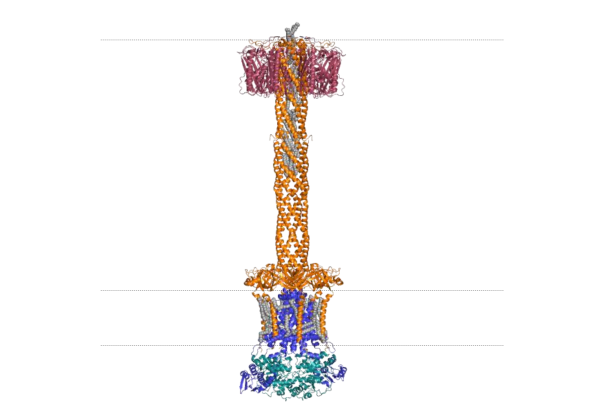
This provides valuable information about a new weakness in the pathogen and therefore provides information on how to combat it more effectively.

Our research, funded by the FNRS and the WEL Research Institute, is fundamental. Of course, we are still in the very early stages of developing applied processes. But we are taking another step towards unlocking the secrets of Brucella's armour so that one day we can hope to control the disease with an effective vaccine
An international research team
- Adélie Lannoy (currently post-doc in Toulouse) and Xavier De Bolle (URBM, UNamur – Belgium)
- Marc Dieu and Patsy Renard (UNamur, URBC - Belgium)
- Antonia García Fernández (Centro de Metabolómica y Bioanálisis (CEMBIO), Facultad de Farmacia, Universidad San Pablo-CEU – Spain)
- Raquel Condez-Alvarez (Department of Microbiology and Parasitology, Instituto de Investigación Sanitaria de Navarra (IdiSNA)University of Navarra – Spain)
The researchers would like to thank the FNRS and the WEL Research Institute for their support in this research. They would also like to thank the ‘Mass Spectrometry – MaSUN’ platform and the ‘Level 3 Biosafety Laboratory – BL3’ technology platform at UNamur for their cutting-edge equipment and expertise.
Xavier De Bolle - Mini CV
Xavier De Bolle presented his doctorate at UNamur (FUNDP at the time) in 1995. After 4 years of post-doc, including one at the University of Oxford, he joined URBM (Biology, Sciences), where he leads a research group. He has supervised 25 doctoral theses (including 4 in progress) and some of his former students have generated their own research team (at the UNamur, the UCLouvain, the VUB).
Professor Xavier De Bolle is a member of the URBM in the Department of Biology at the Faculty of Science of the University of Namur. He is a member of the Namur Research Institute for Life Sciences (Narilis).
Since June 2024, he is also a researcher at the WEL Research Institute for the Welbio-Health programme in the field of ‘Microbiology and Infectious Diseases’.
This work illustrates the cutting-edge expertise developed at UNamur in the field of molecular microbiology, an area in which UNamur has decided to invest by organising a master's degree in molecular microbiology since September 2019. This is a unique master's degree in Europe, taught entirely in English and rooted in research.
Find out more
- New clues to break through Brucella's armour (02/27/2023) - https://unamur.be/fr/newsroom/de-nouveaux-indices-pour-percer-larmure-de-brucella
- Alison Forrester and Xavier De Bolle awarded grants from the latest FRFS-Welbio call for projects (07/23/2024) - https://unamur.be/fr/newsroom/laureats-dernier-appel-projets-frfs-welbio

Namur researchers score highly in F.R.S.-FNRS "Grants and mandates" 2025 call for proposals
Namur researchers score highly in F.R.S.-FNRS "Grants and mandates" 2025 call for proposals
On July 1, 2025, the F.R.S.-FNRS published the list of winners of the various doctoral and postdoctoral mandates, Télévie projects and co-financing with the Fonds de recherche du Québec. Among these, many UNamur researchers were awarded funding. UNamur's particularly high ranking rate demonstrates the quality and excellence of research on the Namur campus.

Four researchers obtained a mandat d'aspirant enabling them to start doctoral research:
- Ludovic DUBOIS and Niccolò PARDINI from the Faculty of Philosophy and Letters,
- Jordan ABRAS from the Faculty of Economics Management Communication sciencesPo (EMCP)
- Noah DEVEAUX from the Faculty of Science.
Success is also on the cards for the postdoctoral researchers, nine of whom have been awarded a research fellowship for 3 years.
- Audrey LEPRINCE, Ciska DE RUYVER, Dmytro STRILETS and Cinzia TOMASELLI from the Faculty of Sciences
- Nicolas MICHEL, Sébastien VANDENITTE and Manon HOUTART from the Faculty of Philosophy and Letters
- Pierre-Yves HUREL and Sebastian RONDEROS from the Faculty of Economics Management Communication sciencesPo (EMCP).
In addition, two new qualified researchers join our university.
- Marie DELABY in the Biology Department of the Faculty of Science
- Matthieu PIGNOT in the History Department of the Faculty of Philosophy and Letters
Three Namur researchers have also obtained funding from the Télévie call.
- Marc HENNEQUART for research aimed at highlighting new metabolic biomarkers for better detection of pancreatic cancer
- Carine MICHIELS for research into the resistance of glioblastoma to radiotherapy combined with chemotherapy
- Anne-Catherine HEUSKIN for research into understanding the reprogramming of macrophage immune cells in the formation of the tumor microenvironment.
Frédéric SILVESTRE (Faculty of Science, Department of Biology, URBE) has also been awarded funding for a FNRS-FRQ collaborative project with ULiège and Quebec teams from the Université de Montréal and the Université du Québec à Montréal. The aims of this project are to develop a new method of age determination based on molecular modifications (epigenetic clock) in beluga whales (Delphinapterus leucas) from the St. Lawrence estuary in Quebec, and to understand the role of age on contaminant accumulation as well as on their stress levels and health status. This will enable better decisions to be made to improve the recovery of this endangered population. As part of this project, two doctoral theses (one in Namur and one in Montreal) are open. Candidates must be biologists (or degree deemed equivalent) with an interest in conservation and ecotoxicology issues, and with experience in molecular biology (omics) and bioinformatics.
Congratulations to them!

Biodiversity of American rivers analyzed over 30 years
Biodiversity of American rivers analyzed over 30 years
A team of American researchers, with the help of Frédérik De Laender, professor in the Department of Biology at UNamur, has just published in the prestigious journal Nature. Their study describes how changing stream temperatures and human introductions of fish can alter river biodiversity in the USA.

In 2021, Professor Frédérik De Laender was approached by American researchers to contribute to a study on the evolution of aquatic diversity in rivers in the USA. The aim: to analyze changes in aquatic diversity and identify the factors behind them. To answer this question, the researchers analyzed data collected over thirty years, covering 389 fish species in nearly 3,000 rivers and streams.
"There was already a lot of data on aquatic diversity in the USA, but it was scattered, recorded in different formats and produced using a variety of techniques and methodologies," explains Frédérik De Laender. "The challenge was therefore to harmonize them, in order to form a coherent whole, capable of revealing trends over several decades and on a continental scale."
Observed trends
In this study entitled "Diverging fish biodiversity trends in cold and warm rivers and streams" researchers studied 389 fish species in 2,992 rivers and streams, between 1993 and 2019. The results show contrasting trends depending on water temperature:
- In cold waters (< 15.4°C), the number of fish fell by 53% and the number of species by 32%. Small fish have declined, replaced by larger species often introduced for sport fishing.
- In warm waters (> 23.8°C), by contrast, the number of individuals has increased by 70% and diversity by 16%, with small opportunistic species dominating.
- Intermediate streams (15-24°C) showed little change.
These trends show that temperature changes and the introduction of certain fish species for fishing are helping to transform local aquatic communities.

The good news is that our results also indicate that targeted management actions, such as river restoration, limiting introductions or adapting fishing practices, can have a positive impact.
Frédérik De Laender - Mini CV
Frédérik De Laender is Professor in the Biology Department at the University of Namur, where he heads the Environmental Ecology of Ecosystems Laboratory (ECCOLOGY lab). He is director of the Environmental and Evolutionary Biology Research Unit (URBE) and also a member of the Life-Earth-Environment (ILEE) and Complex Systems (naXys) Institutes at UNamur.

Frédérik De Laender is a theoretical community ecologist who studies the links between environmental change, biodiversity and ecosystem functioning. Primarily focused on modeling, he has also conducted experiments on plankton and contributed to meta-analyses. His work focuses in particular on ecological stability and coexistence, to better understand the mechanisms that determine community composition.
La recherche au Département de biologie
Le Département de biologie, riche de ses professeurs permanents mène une recherche scientifique internationale de pointe. Celle-ci se répartit entre 5 unités de recherche abordant des thématiques variées de biologie cellulaire et moléculaire, de microbiologie moléculaire, de biologie environnementale et évolutive, de biologie végétale et de didactique.

Understanding for better protection: an innovative joint FNRS-FRQ research project on the St. Lawrence beluga whale
Understanding for better protection: an innovative joint FNRS-FRQ research project on the St. Lawrence beluga whale
A project submitted by Professor Frédéric Silvestre's Laboratoire de Physiologie Évolutive et Adaptative (LEAP) at the University of Namur has been ranked among the top 6 research projects funded by the FNRS and the Fonds de recherche du Québec (FRQ) for scientific collaboration between Wallonia and Quebec. The aim? To understand the impact of human activities on St. Lawrence Estuary (SLE) belugas, using interdisciplinary approaches to help improve conservation strategies for this threatened species.
.
The beluga whale (Delphinapterus leucas) of the St. Lawrence Estuary (SLE) in Quebec, Canada, lives in a marine ecosystem heavily impacted by human activities and has shown no signs of recovery for several decades. Also known as the white whale or white dolphin, the beluga has a life expectancy of around 70 years. Infectious diseases and an increase in post-partum mortality in females have been observed, but the exact causes remain undetermined. However, exposure to contaminants is thought to be one of the causes of the increase in early mortality observed in recent years.
One of the main limitations to assessing the health of individuals in this population in relation to contaminant exposure is the lack of a method for determining the age of live beluga whales in the ESL.
Until now, the most reliable method for determining their age was to count the growth streaks on the inside of their teeth. The expertise of Namur-based researchers at Professor Frédéric Silvestre's Laboratoire de Physiologie Évolutive et Adaptative (LEAP) will enable the development of a new "epigenetic clock" and its use to estimate the age of living belugas, ultimately improving conservation strategies to help this threatened population recover.

An epigenetic clock to determine the age of belugas
The project is entitled: "Une horloge épigénétique pour estimer l'âge des belugas du Saint-Laurent et son impact sur l'accumulation de contaminants, le stress et la santé de cette population menacée"
Epigenetics is the study of changes in gene activity, not involving modification of the DNA sequence, that can be transmitted during cell divisions. One of the elements that "regulate" gene expression is methylation: a chemical group that attaches itself to certain places on the DNA strand to promote or limit gene expression. In recent decades, it has been discovered that methylation changes in a predictable way during aging, according to a pattern known as the "epigenetic clock". Once this clock has been established for a given population of individuals, it is therefore possible to deduce an individual's age by looking for the presence or absence of methylation on DNA. All it takes is a few cells, such as skin cells.
An international, interdisciplinary team
A team of top scientists from both regions is involved.
- Pr Frédéric Silvestre and Dr Alice Dennis - UNamur, Belgium
- Dr Krishna Das - ULiège, Belgium
- Dr Jonathan Verreault - Université du Québec à Montréal, Canada
- Dr Stéphane Lair - Université de Montréal, Canada
- Dr Magali Houde - Environment and Climate Change Canada
- Dr Véronique Lesage - Fisheries and Oceans Canada
- Dr Robert Michaud - Group for Research and Education on Marine Mammals (GREMM), Quebec, Canada
Namur's expertise to preserve biodiversity
The research team will validate this new method and investigate the link with contaminant accumulation, physiological stress and overall health in this threatened population, comparing the ESL population with a healthier population of belugas from the Canadian Arctic.
In summary, this research aims to better understand how biological age, as measured by the epigenetic clock, influences the vulnerability of belugas to environmental stressors and their health.
This project will address fundamental research questions never before explored in beluga whales,
A new PhD student will join the Namur team, under the supervision of Frédéric Silvestre and will work in collaboration with researcher Justine Bélik on the basis of the EpiClock she developed for the mangrove rivulus.
Along with a project on mangrove rivulus in Florida and Belize, and one on fish and invertebrate populations in the Ecuadorian mountains, this is the third scientific project to use Namur researchers' expertise in ecological epigenetics in wild animals to help preserve biodiversity.
FNRS - The freedom to search
Collaborative research F.R.S.-FNRS - FRQ (Fédération Wallonie-Bruxelles - Québec)
The F.R.S.-FNRS has launched PINT-Bilat-P calls for bilateral research projects with the Fonds de Recherche du Québec. These calls are part of a drive to develop strategic partnerships. The aim of this bilateral research program is to create a leverage effect for scientific excellence and to encourage researchers from the Wallonia-Brussels Federation and Quebec to develop innovative joint research projects.

A prestigious publication for an international microbiology research team
A prestigious publication for an international microbiology research team
The team of professor Xavier De Bolle has just published an article in the prestigious EMBO Journal published by Springer Nature. His discovery? A lipid transport channel through the cell membrane of Brucella, the bacteria responsible for Brucellosis in cattle. This finding could be used to generate attenuated strains of the bacteria; a process used in vaccine manufacturing.

The study of Brucella is one of the areas of microbiology in which UNamur research teams have specialised for more than twenty years. This pathogenic bacteria infects livestock, causing Brucellosis, a disease that can be transmitted to humans through the consumption of unpasteurised dairy products, contact with infected animal tissue or inhalation. It is one of the most widespread zoonoses in the world.
A catalogue of weaknesses
Over the years of research, the team led by Professor Xavier De Bolle, Professor in the Department of Biology, member of the Microorganism Biology Research Unit (URBM) at the University of Namur and investigator at the WEL Research Institute, has been able to establish a kind of “catalogue” of Brucella's weaknesses.
There are millions of species of bacteria. It is therefore impossible to study them on a case-by-case basis. However, they have similar behaviours and functions, which is why a specific bacterium is considered the model: Escherichia coli (or E. coli), an intestinal bacteria found in warm-blooded organisms. Discovered in 1885, it has been the subject of numerous studies and has therefore become a reference in scientific literature.
A bacterium such as E. coli or Brucella is like an onion with only two layers (inner and outer membrane) and a central element (the cytoplasm) in which the organism produces everything it needs. It also exports elements to the outside, particularly lipids. However, these processes are still poorly understood, even for E. coli. Nevertheless, they represent an interesting avenue to explore to reach the heart of the pathogenic bacteria.
Mutants pave the way
During this research, which combined bacteriology and genetics, the researchers developed a technology that allows them to induce mutations in Brucella and also to identify where these mutations are located. They succeeded in creating a mutant that showed them the way to a veritable ‘lipid tunnel’, a passageway in the inner and outer membrane walls of the bacteria.

This provides valuable information about a new weakness in the pathogen and therefore provides information on how to combat it more effectively.

Our research, funded by the FNRS and the WEL Research Institute, is fundamental. Of course, we are still in the very early stages of developing applied processes. But we are taking another step towards unlocking the secrets of Brucella's armour so that one day we can hope to control the disease with an effective vaccine
An international research team
- Adélie Lannoy (currently post-doc in Toulouse) and Xavier De Bolle (URBM, UNamur – Belgium)
- Marc Dieu and Patsy Renard (UNamur, URBC - Belgium)
- Antonia García Fernández (Centro de Metabolómica y Bioanálisis (CEMBIO), Facultad de Farmacia, Universidad San Pablo-CEU – Spain)
- Raquel Condez-Alvarez (Department of Microbiology and Parasitology, Instituto de Investigación Sanitaria de Navarra (IdiSNA)University of Navarra – Spain)
The researchers would like to thank the FNRS and the WEL Research Institute for their support in this research. They would also like to thank the ‘Mass Spectrometry – MaSUN’ platform and the ‘Level 3 Biosafety Laboratory – BL3’ technology platform at UNamur for their cutting-edge equipment and expertise.
Xavier De Bolle - Mini CV
Xavier De Bolle presented his doctorate at UNamur (FUNDP at the time) in 1995. After 4 years of post-doc, including one at the University of Oxford, he joined URBM (Biology, Sciences), where he leads a research group. He has supervised 25 doctoral theses (including 4 in progress) and some of his former students have generated their own research team (at the UNamur, the UCLouvain, the VUB).
Professor Xavier De Bolle is a member of the URBM in the Department of Biology at the Faculty of Science of the University of Namur. He is a member of the Namur Research Institute for Life Sciences (Narilis).
Since June 2024, he is also a researcher at the WEL Research Institute for the Welbio-Health programme in the field of ‘Microbiology and Infectious Diseases’.
This work illustrates the cutting-edge expertise developed at UNamur in the field of molecular microbiology, an area in which UNamur has decided to invest by organising a master's degree in molecular microbiology since September 2019. This is a unique master's degree in Europe, taught entirely in English and rooted in research.
Find out more
- New clues to break through Brucella's armour (02/27/2023) - https://unamur.be/fr/newsroom/de-nouveaux-indices-pour-percer-larmure-de-brucella
- Alison Forrester and Xavier De Bolle awarded grants from the latest FRFS-Welbio call for projects (07/23/2024) - https://unamur.be/fr/newsroom/laureats-dernier-appel-projets-frfs-welbio

Namur researchers score highly in F.R.S.-FNRS "Grants and mandates" 2025 call for proposals
Namur researchers score highly in F.R.S.-FNRS "Grants and mandates" 2025 call for proposals
On July 1, 2025, the F.R.S.-FNRS published the list of winners of the various doctoral and postdoctoral mandates, Télévie projects and co-financing with the Fonds de recherche du Québec. Among these, many UNamur researchers were awarded funding. UNamur's particularly high ranking rate demonstrates the quality and excellence of research on the Namur campus.

Four researchers obtained a mandat d'aspirant enabling them to start doctoral research:
- Ludovic DUBOIS and Niccolò PARDINI from the Faculty of Philosophy and Letters,
- Jordan ABRAS from the Faculty of Economics Management Communication sciencesPo (EMCP)
- Noah DEVEAUX from the Faculty of Science.
Success is also on the cards for the postdoctoral researchers, nine of whom have been awarded a research fellowship for 3 years.
- Audrey LEPRINCE, Ciska DE RUYVER, Dmytro STRILETS and Cinzia TOMASELLI from the Faculty of Sciences
- Nicolas MICHEL, Sébastien VANDENITTE and Manon HOUTART from the Faculty of Philosophy and Letters
- Pierre-Yves HUREL and Sebastian RONDEROS from the Faculty of Economics Management Communication sciencesPo (EMCP).
In addition, two new qualified researchers join our university.
- Marie DELABY in the Biology Department of the Faculty of Science
- Matthieu PIGNOT in the History Department of the Faculty of Philosophy and Letters
Three Namur researchers have also obtained funding from the Télévie call.
- Marc HENNEQUART for research aimed at highlighting new metabolic biomarkers for better detection of pancreatic cancer
- Carine MICHIELS for research into the resistance of glioblastoma to radiotherapy combined with chemotherapy
- Anne-Catherine HEUSKIN for research into understanding the reprogramming of macrophage immune cells in the formation of the tumor microenvironment.
Frédéric SILVESTRE (Faculty of Science, Department of Biology, URBE) has also been awarded funding for a FNRS-FRQ collaborative project with ULiège and Quebec teams from the Université de Montréal and the Université du Québec à Montréal. The aims of this project are to develop a new method of age determination based on molecular modifications (epigenetic clock) in beluga whales (Delphinapterus leucas) from the St. Lawrence estuary in Quebec, and to understand the role of age on contaminant accumulation as well as on their stress levels and health status. This will enable better decisions to be made to improve the recovery of this endangered population. As part of this project, two doctoral theses (one in Namur and one in Montreal) are open. Candidates must be biologists (or degree deemed equivalent) with an interest in conservation and ecotoxicology issues, and with experience in molecular biology (omics) and bioinformatics.
Congratulations to them!
Agenda
MDAH 2026 conference
15th International Symposium on Marek's Disease and Avian Herpesviruses.
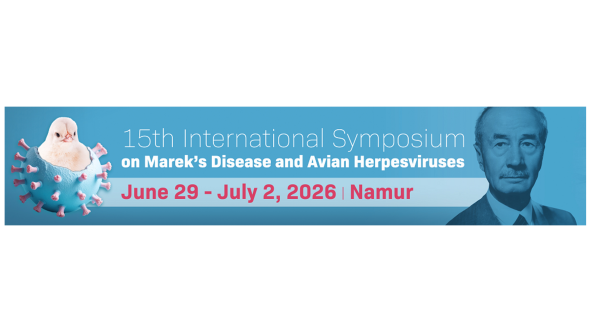
Every two years, the International Symposium on Marek's Disease and Avian Herpesviruses (MDAH) brings together researchers from around the world to exchange the latest insights on poultry viral diseases - covering their biology, evolution, control strategies, and epidemiology. Attendees include PhD students, postdocs and researchers representing academia, government, and commercial organizations from North and South America, Europe, Asia, the Middle East, Australia, and Africa.
